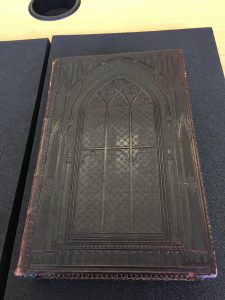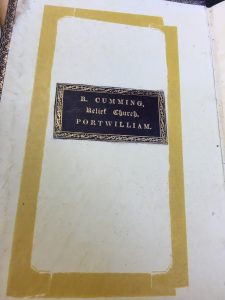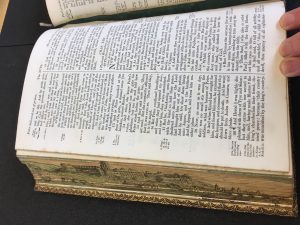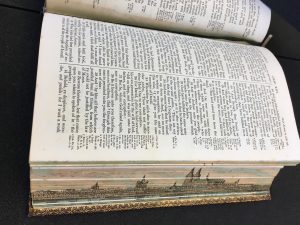Another King James Bible in the collection is the Holy Bible including The Psalms of David in Metre, a text extremely similar to the Bible I mentioned in my previous post, but also quite different; namely, that one is from Edinburg, Scotland, while the other is from London, England. Therefore, the Scottish Bible in conversation with the aforementioned Bible can help us begin to understand that even though England and Scotland represent different denominations of Presbyterianism, their Bibles demonstrate more similarities than one would think.
But first a little background on the formal qualities of the Scottish Holy Bible. This Bible features a design on both the front and back covers of the interior architectural elements of a Gothic cathedral including arches, windows, and stone tracery. The main window on the cover of the Bible also shows an exterior view of another cathedral, potentially Wells Cathedral. While this may not seem particularly significant, it establishes a direct link to England because Wells Cathedral is located in Somerset, England. Why not place a Scottish cathedral on the cover of a Scottish Bible? The answer to that question potentially lies with a stamp located towards the bottom half of the front and back cover stating that the Bible was bound by Remnant & Edmonds, a bookbinding partnership consisting of Thomas Remnant and Jacobs Edmonds (established in 1831) who were located at 8-10 Lovell’s Court, London. Since the bookbinders were English they may have been more inclined to depict a famous English cathedral that they were familiar with rather than a Scottish cathedral. This demonstrates the potential inter-connectedness of English and Scottish bible industries or could simply be an illustration of the desires of the possible first owner of this Bible, R. Cumming of the Relief Church in Portwilliam, Scotland.


It is unclear whether R. Cumming was a pastor of this church in Portwilliam or if he was simply a parishioner. However, the inclusion of the English cathedral on the cover as well as the German-themed fore-edge painting may be an indication that R. Cumming was a parishioner. This Scottish Bible has a double fore-edge painting that can be seen if the bible is opened at the Acts of the Apostles in the New Testament. On the left hand side there is a view of the City of Heidelberg, which is located on a rocky landscape overlooking the Rhine river. In the background of the left fore-edge painting, there is an arched bridge and some ships closest to the viewer. On the right hand side there is a view of the city of Cologne from the Rhine. High-pitch roofed houses made of stone and timber can be seen, as well as the Cologne Cathedral to the far right and another large church with a spire in the center of the scene. Again why would a Scottish Bible include religious architecture from Germany? Since this bible includes no other form of illustration or any sort of handwritten notes, both the cover and the fore-edge painting are the only glimpse we have into R. Cumming and future owners of this bible. Maybe Cumming visited Wells Cathedral once, which is why he wanted it incorporated into his personal bible with a similar thought process attached to the German scene in the fore-edge painting. Either way this Scottish Bible is intriguing in that it incorporates imagery that does not really have any connection to Scotland.

